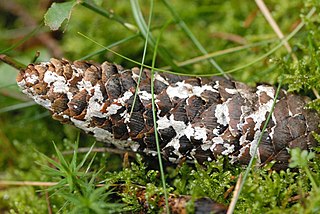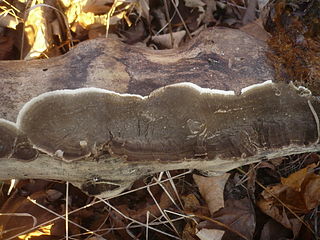
Phanerochaete is a genus of crust fungi in the family Phanerochaetaceae.

Atheliaceae is a family of mostly corticioid fungi placed in the order Atheliales. Both the order and the family were described by the Swiss mycologist Walter Jülich in 1981 along with three other families, Lobuliciaceae, Byssocorticiaceae, Pilodermataceae and Tylosporaceae discovered in 2020. According to a 2008 estimate, the family contains 20 genera and approximately 100 species. However, many genera formerly considered to belong in the Atheliaceae have since been moved to other families, including Amylocorticiaceae, Albatrellaceae, and Hygrophoraceae. Despite being a relatively small group with inconspicuous forms, Atheliaceae members show great diversity in life strategies and are widespread in distribution. Additionally, being a group strictly composed of largely corticioid fungi, they may also provide insights on the evolution of fruiting body forms in basidiomycetes.

The Meruliaceae are a family of fungi in the order Polyporales. According to a 2008 estimate, the family contains 47 genera and 420 species. As of April 2018, Index Fungorum accepts 645 species in the family.

The Phanerochaetaceae are a family of mostly crust fungi in the order Polyporales.

The Hymenochaetaceae are a family of fungi in the order Hymenochaetales. The family contains several species that are implicated in many diseases of broad-leaved and coniferous trees, causing heart rot, canker and root diseases, and also esca disease of grapevines.
Candelabrochaete is a genus of crust fungi in the family Phanerochaetaceae.

Phlebia is a genus of mostly crust fungi in the family Meruliaceae. The genus has a widespread distribution. Phlebia species cause white rot.

Mycoaciella is a genus of corticioid fungi in the family Meruliaceae. The genus was circumscribed by John Eriksson and Leif Ryvarden in 1978. After microscopic examination of the three species then in the genus, Karen Nakasone proposed to synonymize Mycoaciella with Phlebia.

Porostereum is a genus of poroid crust fungi in the family Phanerochaetaceae. It was circumscribed by Czech mycologist Albert Pilát in 1937.

Phlebiopsis is a genus of poroid crust fungi in the family Phanerochaetaceae. The genus contains 11 species, which collectively have a widespread distribution. The genome sequence of the type species, Phlebiopsis gigantea, was published in 2014.
Hjortstamia is a genus of corticioid fungi in the family Phanerochaetaceae. It was circumscribed by French mycologists Jacques Boidin and Gérard Gilles in 2003.
Gloeohypochnicium is a genus of wood-inhabiting crust fungi of uncertain familial placement in the order Russulales. Originally conceived by Erast Parmasto as a subgenus of Hypochnicium, Kurt Hjortstam considered it worthy of distinct generic status in 1987. The type species, G. analogum, was described as new to science in 1913 by French mycologists Hubert Bourdot and Amédée Galzin as a species of Gloeocystidium. G. versatum was added to the genus in 2010.

Hyphoderma is a genus of crust fungi in the family Hyphodermataceae. It was circumscribed by German botanist Karl Friedrich Wilhelm Wallroth in 1833.
Pirex is a fungal genus in the family Meruliaceae. It is a monotypic genus, containing the single crust fungus Pirex concentricus. It is found in the Pacific Northwest region of North America, where it causes a white rot in woody hardwood and conifer debris generated by timber harvesting.

The corticioid fungi are a group of fungi in the Basidiomycota typically having effused, smooth basidiocarps that are formed on the undersides of dead tree trunks or branches. They are sometimes colloquially called crust fungi or patch fungi. Originally such fungi were referred to the genus Corticium and subsequently to the family Corticiaceae, but it is now known that all corticioid species are not necessarily closely related. The fact that they look similar is an example of convergent evolution. Since they are often studied as a group, it is convenient to retain the informal (non-taxonomic) name of "corticioid fungi" and this term is frequently used in research papers and other texts.

Xylodon is a genus of crust fungi in the family Schizoporaceae.
Botryodontia millavensis is a species of fungus belonging to the family Phanerochaetaceae.

Cristinia is a genus of fungi belonging to the family Stephanosporaceae.

John Leonard Eriksson was a Swedish mycologist. He specialized in crust fungi of the basidiomycetes, collecting in Sweden, Finland and Canada.
Intextomyces is a genus of fungi belonging to the family Hyphodermataceae.












